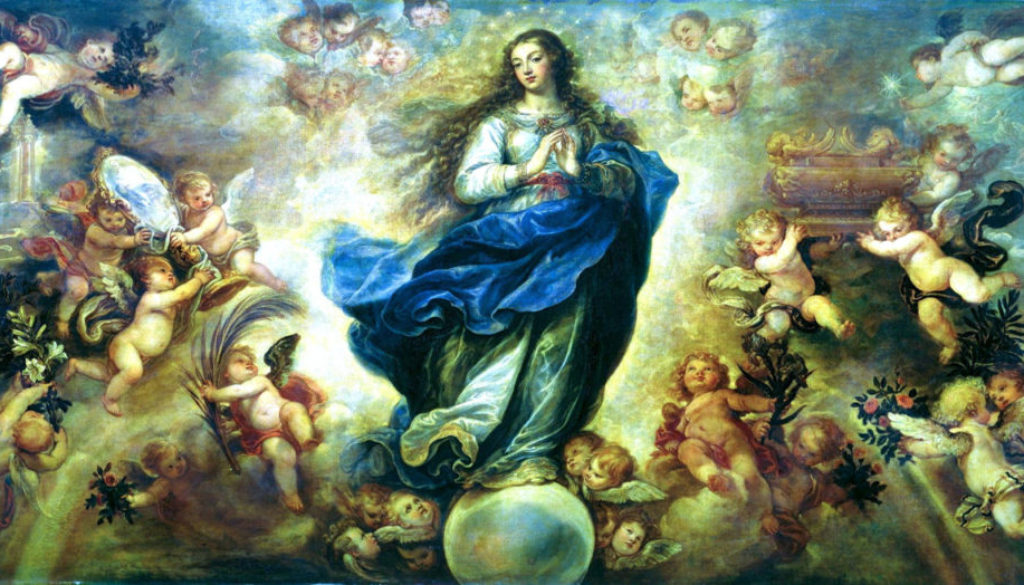An Homage to Our Lady

Atlanta, GA
December 8, 2021
The Lord possessed me in the beginning of His ways, before He made anything, from the beginning. I was set up from eternity, and of old, before the earth was made. The depths were not as yet, and I was already conceived….He that shall find me shall find life, and shall have salvation from the Lord.
– Proverbs 8: 22-35
A few days ago we had a treat. Our cousins Katy and Perry Accardo were in town, and helped us drown the day in a few bottles of wine. We’d not seen them since we were in Walla Walla last summer, so we had a lot of ground to cover. Fortunately, we had plenty of fuel.
To honor the memory of our last time together, we retrieved a bottle of L’Ecole No. 41 Semillon we’d purchased at the downtown winery just before the Accardos left Walla Walla. Amid our decked halls and a warm fire, we drained the contents, moved on to Malbec, and laughed away all the insufferable problems we were unable to solve.
Having resorted Sunday to worldly pleasure and mundane mockery, we rest today on supernatural support.
This is the first Holy Day of Obligation in the Catholic liturgical year. As it honors one of the four Marian dogmas of the Church, it is also among the more controversial. Today we celebrate the Immaculate Conception of the Blessed Virgin Mary.
Contrary to popular opinion, this does not refer to the conception of Christ in the womb of Mary, nor to a reception by Franco Harris of a pass from Terry Bradshaw. My family is Catholic and my father’s side was from Pittsburgh, so we acknowledge those as momentous occasions. But they are not the ones we honor today.
Tho’ not defined as dogma till Pope Pius IX did so in 1854, the idea that Mary was conceived without Original Sin extends into the early centuries of the Christian era. Usually because they are misunderstood (intentionally or otherwise), the Marian maxims remain among the most controversial Catholic beliefs among non-Catholic critics…and even many “Catholic” ones.
Divine Motherhood, Perpetual Virginity, the Immaculate Conception, and the Assumption of Mary tend to raise eyebrows and giggles among sophisticated skeptics and the purveyors of “science.”
Ecumenical Catholics and worldly prelates also blush that gullible rubes remain moved by such quaint beliefs.
As Joe Sobran once said, “The Blessed Virgin defines the Faith as nothing else does. Catholics who have an aversion to speaking of her are nearly always on their way out of the Church, because she represents total humility and purity, the very opposites of the modern spirit. You can divide people into those she inspires and those she embarrasses.”
The embarrassed are often the same people who chastise the Church for its “subjugation” of women, and then mock it for its elevation of Mary. In doing so, they misunderstand (or misrepresent) the Catholic perspective on both.
As witnesses to the Resurrection and as saints down the centuries, women have always played central rôles in the history of the Church, and Our Mother is their model. Aside from Christ Himself, this humble woman holds the highest place in Catholic hearts.
A sizable portion of the enlightened contingent argues that Pius IX conceived the Conception to exalt the papacy. This was in the wake of the Enlightenment and the dawn of Darwin. Among the “respectables”, doubt was rife.
Some appealed to the qualms of St Thomas Aquinas regarding the Immaculate Conception to attest that Pius invented the doctrine to consolidate papal power. But that argument backfired.
However esteemed that saintly source, and however legitimate his thirteenth century concerns, that Thomas Aquinas had to argue against the Immaculate Conception at least shows that the idea was widely believed long before Pius IX made it incumbent on Catholics.
And why wouldn’t it have been? It stands to reason.
“I will put enmities between thee and the woman.’ Thus spoke the Lord to the serpent after it had enticed our first parents. He thus foretold the Immaculate Conception of the second Eve.
At the Annunciation, the Angel Gabriel hails Mary as being “full of grace”, meaning she contains nothing else, especially sin. This dearth of defect enabled her eventual glory, by preparing her womb to be the repository of God.
The Blessed Virgin, as the Baltimore Catechism reminds us, was destined to be the Mother of God. Had she suffered Original Sin before the Redemption of the Crucifixion or the Sacraments, then she’d have be liable to mortal sin by contaminating Christ.
Since whatever disgraces a mother degrades her son, Christ, thru His merits, saved her from stain. The vessel who carried the Savior was spared the corruption common to every other soul.
But it wasn’t only for Christ to be sinless that Mary was spotless. Like eye color, dimples, and bad jokes, Original Sin is passed from the father to the child. As such, Christ could’ve been pure even had Mary been tainted. But God, knowing his servant would accept the Annunciation and fulfill her rôle, had her cleansed of sin thru the merits of His Son.
Rationalist Protestants have objected that were Mary conceived without sin, her parents (and their ancestors in a continuous regression back to Adam) must’ve been too. But it was the intervention of God, not the purity of Joachim, that precluded her blemish.
John Henry Newman noted that Protestant Reformers believed devotion to Mary detracted from worship of Our Lord. But the opposite is true. When adoration for Our Lady diminishes, faith in Our Lord…including such essentials as Virgin Birth and even His Divinity…inevitably falls too.
Being a Day of Obligation, I began the morning by hearing Mass. Or, rather, the priest began the morning by hearing Confession. My slate cleaned, I found my pew and bent my knees. A rosary was underway, and I lost myself in the low hum of solemn Latin. As we completed the last decade and said the Salve Regina, the bells chimed and the priest entered.
The Church was full, yet relatively quiet, which is part of the appeal of the Tridentine Latin Mass. Veils covered the ladies, who comprised most of the congregation. It was ethereal and the eternal, not tangible and the mundane. It exuded the sacred, not the schmaltz, and was a welcome path from a coarse world to a higher plane.
It’s not without reason that the Catholic Church is the “Bride of Christ”. It’s an earthly institution that’s out of this world. And on this most solemn feast in the holy season of Advent, it was nice to spend an hour with her. And with her Mother.
JD



